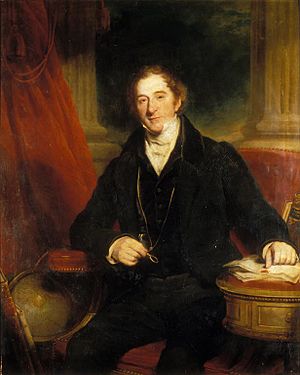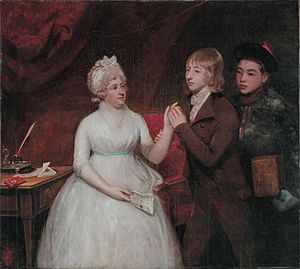Sir George Staunton, 2nd Baronet facts for kids
Sir George Thomas Staunton, 2nd Baronet (born May 26, 1781 – died August 10, 1859) was an English traveler. He was also an Orientalist, meaning he studied the languages, cultures, and history of East Asia.
Early Life and China Trip
George Staunton was born near Salisbury, England. His father, Sir George Leonard Staunton, was a diplomat and also studied East Asian cultures.
In 1792, when George was just 12 years old, he went on an important trip to China. He traveled with his father, who was helping Lord Macartney on a special mission. Before this trip, young George had already started learning Chinese. Because of his language skills, he became a page for Lord Macartney.
During the mission, George's Chinese was good enough for him to talk with important people. He even received a personal gift from the Qianlong Emperor of China! Later, in 1797, he studied at Trinity College, Cambridge.
Working for the East India Company
In 1798, George Staunton began working for the British East India Company in Canton (now called Guangzhou), China. This company was a very powerful British trading group. He started as a "writer" and later became the chief of their factory there. His knowledge of Chinese grew even more during this time.
In 1805, he translated a medical book into Chinese. Five years later, he published an English translation of a big part of the Chinese legal code. This was a very important achievement.
In 1801, he inherited his father's special title, becoming the 2nd Baronet. A baronet is like a knight, and the title can be passed down in the family. In 1803, he became a member of the Royal Society, a famous group for scientists.
Many people came to George Staunton for help with learning Chinese and settling in China. These included Robert Morrison and Thomas Manning, who were also interested in Chinese culture.
In 1816, Staunton went on another special mission to Beijing with Lord Amherst. During this trip, he landed in Hong Kong. He walked through areas that were later named after him, like Staunton Creek and Staunton Valley. Today, Staunton Street in Central, Hong Kong, is also named in his honor.
The mission to Beijing was not successful. Soon after, Staunton decided to leave China for good.
Life Back in Britain
After returning from China, George Staunton looked for a country home. In 1820, he bought a large estate in Hampshire, England. This land later became Staunton Country Park. He lived there part of each year and made many changes to the buildings and the landscape.
Three years later, he helped start the Royal Asiatic Society of Great Britain and Ireland. This society is still active today and gives out a "Sir George Staunton prize" every year.
Between 1818 and 1852, he was a Member of Parliament (MP) for several areas in England, including Portsmouth. An MP is someone elected to help make laws for the country. He was also a member of the East India Committee.
George Staunton never married. When he died in London in 1859, his baronet title ended because he had no children to pass it to. He left his properties to his cousins.



